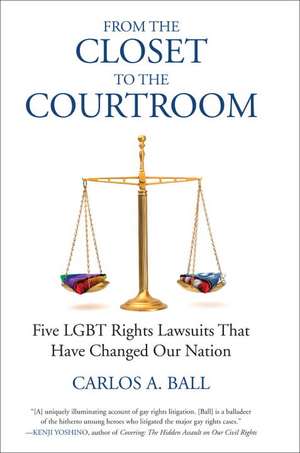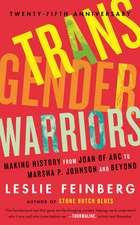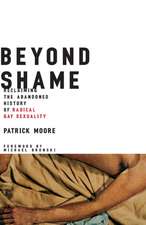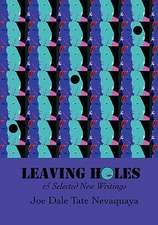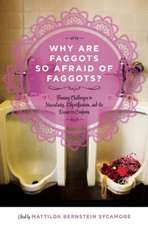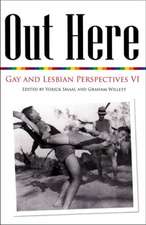From the Closet to the Courtroom: Five LGBT Rights Lawsuits That Have Changed Our Nation: Queer Actions/Queer Ideas
Autor Carlos A. Ballen Limba Engleză Paperback – 30 apr 2011
Preț: 152.07 lei
Nou
Puncte Express: 228
Preț estimativ în valută:
29.11€ • 31.63$ • 24.47£
29.11€ • 31.63$ • 24.47£
Carte tipărită la comandă
Livrare economică 21 aprilie-05 mai
Preluare comenzi: 021 569.72.76
Specificații
ISBN-13: 9780807001530
ISBN-10: 0807001538
Pagini: 286
Dimensiuni: 152 x 226 x 20 mm
Greutate: 0.45 kg
Editura: Beacon Press (MA)
Seria Queer Actions/Queer Ideas
ISBN-10: 0807001538
Pagini: 286
Dimensiuni: 152 x 226 x 20 mm
Greutate: 0.45 kg
Editura: Beacon Press (MA)
Seria Queer Actions/Queer Ideas
Notă biografică
Carlos A. Ball is professor of law at the Rutgers University School of Law (Newark). He has written extensively on LGBT rights issues, is the author of The Morality of Gay Rights, and has received a Dukeminier Award from UCLA’s Williams Institute for excellence in sexual orientation and the law scholarship. He lives with his family in Brooklyn, New York.
Extras
From the Introduction
The LGBT rights movement has had many heroes, some who have received a great deal of national attention, and others whose names we will never know. Indeed, the advancement of LGBT rights has come about through struggles large and small—on the streets, around kitchen tables, in newspapers and on the Internet, and in courtrooms across the country. The list of individuals who have participated is long, and it includes the drag queens who congregated at the Stonewall Inn and who decided in 1969 to push back against police harassment and intimidation; the gay rights activists who in 1978 defeated a California ballot measure that would have led to the firing of gay public school teachers throughout the state; the thousands of volunteers who in the 1980s helped to care for, and fought on behalf of, people with AIDS; and the many who came together to mourn and celebrate the life of Matthew Shepard, who in 1998 was brutally beaten to death in Laramie, Wyoming, for being gay.
One important piece of the struggle for LGBT rights has involved lawsuits. This book tells the story of five lawsuits that have worked in conjunction with political mobilization and social protests to remake our nation’s political, social, and moral landscape.
In many ways, overcoming invisibility is the first step in successfully demanding basic civil rights. In fact, it is perhaps no coincidence that Invisible Man, Ralph Ellison’s novel about the pain and misery associated with the invisibility of black people in America, was published only two years before the Supreme Court issued its opinion in Brown v. Board of Education. Brown compelled our country to recognize the capabilities and hopes of African Americans. Black people after Brown may still have been hated by some and feared by others, but they were no longer invisible. After Brown, it was no longer tenable to reject out of hand the claims of African Americans to basic equality.
Similarly, the five lawsuits explored in this book have required our nation to take seriously the claims of LGBT people to equal citizenship. The primary goal of laws and policies that discriminate on the basis of sexual orientation is to discourage LGBT individuals from being open about who they are and whom they love. In contrast, the five lawsuits chronicled here have helped to make LGBT people visible by forcing society to grapple with both their existence and their aspirations.
In Braschi v. Stahl Associates (1989), an American appellate court for the first time concluded that it is possible for two men in an intimate relationship to constitute a family. Prior to Braschi, same-sex relationships, no matter how close or long-lasting, had no greater legal significance than those of friends or roommates. As we will see, the LGBT rights movement used the Braschi litigation to encourage the courts—and, through them, the public—to take a hard look at a particular loving relationship between two men in order to make its case that LGBT people are as capable of forming close and lasting familial ties as are straight people.
As a result of Nabozny v. Podlesny (1996), a jury in rural Wisconsin concluded that school officials violated the constitutional rights of a gay teenager when they permitted other students to harass him in violent and demeaning ways because of his sexual orientation. Prior to this case, the intense physical and emotional suffering of countless LGBT students in American schools at the hands of homophobic students went largely unacknowledged by school officials and the public at large. It took a federal constitutional lawsuit to render visible the plight of the many LGBT students who have to cope with repeated instances of violence and harassment in the hallways and bathrooms of the country’s public schools.
Because of Romer v. Evans (1996), the U.S. Supreme Court held that it is unconstitutional to deny LGBT people the opportunity to seek antidiscrimination protection under the law. At issue in Romer was a Colorado state constitutional amendment that would have made it illegal to protect sexual minorities against discrimination based on their sexual orientation. Supporters of the amendment hoped to push LGBT people back into the closet, but the Court rejected this effort, making it clear that LGBT people are equals under the law and that the government has an obligation to treat them accordingly.
When the Hawaii Supreme Court ruled in Baehr v. Lewin (1993), it became the first American court to question the constitutionality of denying same-sex couples the opportunity to marry, and, in the process, it ignited the marriage equality movement. The same-sex marriage cases, of which Baehr was the first important one, have done more to increase the visibility of LGBT people than any other strategy pursued by the LGBT rights movement in the last twenty years. The lawsuits have forced the country as a whole to grapple with the question of whether it is legally and morally defensible to deny an entire group of individuals access to the hundreds of rights and benefits that our society allocates through the institution of marriage. As a result of Baehr, and of the same-sex marriage cases that followed, it has become much more difficult for Americans to continue to pretend that LGBT people either do not exist or that their needs and aspirations are not worth considering.
In Lawrence v. Texas (2003), the U.S. Supreme Court held that the government cannot criminalize private and consensual gay sex. For decades prior to Lawrence, those who supported discrimination against LGBT people contended that society was entitled to use the criminal law to express disapproval of same-sex sexuality and relationships. The Court in Lawrence ruled that such a position is inconsistent with our nation’s most cherished principles aimed at protecting individual dignity and autonomy. Rather than relegating same-sex sexuality to the realm of the hidden, shameful, and degrading, the Court made it clear that the choices LGBT people make about sexual intimacy are as closely linked to their dignity as human beings as are those of heterosexuals.
The LGBT rights movement has had many heroes, some who have received a great deal of national attention, and others whose names we will never know. Indeed, the advancement of LGBT rights has come about through struggles large and small—on the streets, around kitchen tables, in newspapers and on the Internet, and in courtrooms across the country. The list of individuals who have participated is long, and it includes the drag queens who congregated at the Stonewall Inn and who decided in 1969 to push back against police harassment and intimidation; the gay rights activists who in 1978 defeated a California ballot measure that would have led to the firing of gay public school teachers throughout the state; the thousands of volunteers who in the 1980s helped to care for, and fought on behalf of, people with AIDS; and the many who came together to mourn and celebrate the life of Matthew Shepard, who in 1998 was brutally beaten to death in Laramie, Wyoming, for being gay.
One important piece of the struggle for LGBT rights has involved lawsuits. This book tells the story of five lawsuits that have worked in conjunction with political mobilization and social protests to remake our nation’s political, social, and moral landscape.
In many ways, overcoming invisibility is the first step in successfully demanding basic civil rights. In fact, it is perhaps no coincidence that Invisible Man, Ralph Ellison’s novel about the pain and misery associated with the invisibility of black people in America, was published only two years before the Supreme Court issued its opinion in Brown v. Board of Education. Brown compelled our country to recognize the capabilities and hopes of African Americans. Black people after Brown may still have been hated by some and feared by others, but they were no longer invisible. After Brown, it was no longer tenable to reject out of hand the claims of African Americans to basic equality.
Similarly, the five lawsuits explored in this book have required our nation to take seriously the claims of LGBT people to equal citizenship. The primary goal of laws and policies that discriminate on the basis of sexual orientation is to discourage LGBT individuals from being open about who they are and whom they love. In contrast, the five lawsuits chronicled here have helped to make LGBT people visible by forcing society to grapple with both their existence and their aspirations.
In Braschi v. Stahl Associates (1989), an American appellate court for the first time concluded that it is possible for two men in an intimate relationship to constitute a family. Prior to Braschi, same-sex relationships, no matter how close or long-lasting, had no greater legal significance than those of friends or roommates. As we will see, the LGBT rights movement used the Braschi litigation to encourage the courts—and, through them, the public—to take a hard look at a particular loving relationship between two men in order to make its case that LGBT people are as capable of forming close and lasting familial ties as are straight people.
As a result of Nabozny v. Podlesny (1996), a jury in rural Wisconsin concluded that school officials violated the constitutional rights of a gay teenager when they permitted other students to harass him in violent and demeaning ways because of his sexual orientation. Prior to this case, the intense physical and emotional suffering of countless LGBT students in American schools at the hands of homophobic students went largely unacknowledged by school officials and the public at large. It took a federal constitutional lawsuit to render visible the plight of the many LGBT students who have to cope with repeated instances of violence and harassment in the hallways and bathrooms of the country’s public schools.
Because of Romer v. Evans (1996), the U.S. Supreme Court held that it is unconstitutional to deny LGBT people the opportunity to seek antidiscrimination protection under the law. At issue in Romer was a Colorado state constitutional amendment that would have made it illegal to protect sexual minorities against discrimination based on their sexual orientation. Supporters of the amendment hoped to push LGBT people back into the closet, but the Court rejected this effort, making it clear that LGBT people are equals under the law and that the government has an obligation to treat them accordingly.
When the Hawaii Supreme Court ruled in Baehr v. Lewin (1993), it became the first American court to question the constitutionality of denying same-sex couples the opportunity to marry, and, in the process, it ignited the marriage equality movement. The same-sex marriage cases, of which Baehr was the first important one, have done more to increase the visibility of LGBT people than any other strategy pursued by the LGBT rights movement in the last twenty years. The lawsuits have forced the country as a whole to grapple with the question of whether it is legally and morally defensible to deny an entire group of individuals access to the hundreds of rights and benefits that our society allocates through the institution of marriage. As a result of Baehr, and of the same-sex marriage cases that followed, it has become much more difficult for Americans to continue to pretend that LGBT people either do not exist or that their needs and aspirations are not worth considering.
In Lawrence v. Texas (2003), the U.S. Supreme Court held that the government cannot criminalize private and consensual gay sex. For decades prior to Lawrence, those who supported discrimination against LGBT people contended that society was entitled to use the criminal law to express disapproval of same-sex sexuality and relationships. The Court in Lawrence ruled that such a position is inconsistent with our nation’s most cherished principles aimed at protecting individual dignity and autonomy. Rather than relegating same-sex sexuality to the realm of the hidden, shameful, and degrading, the Court made it clear that the choices LGBT people make about sexual intimacy are as closely linked to their dignity as human beings as are those of heterosexuals.
Recenzii
“Ball revels in a handful of important legal victories, while also delving deeply into the personal stories of each case, resulting in a richly textured account that is part history book, part colorful reportage.”— Beth Greenfield, Time Out New York
“While the gay and lesbian rights movement had its start in 1969 at the Stonewall in New York City, it has yet to have a book tell the story of its poster children and the legal struggles in which they fought. This volume amply fills this void. . . . Well written, exciting, and fun to read.”—Choice Magazine
“Ball dramatically resurrects each case, bringing together opposing attorneys and litigants to show how ordinary human conflict can translate to extraordinary civil rights gain. This groundbreaking book is crucial if we are to understand the history of the rights we take for granted.”—Mary Bonauto, Civil Rights Project director for GLAD, Gay & Lesbian Advocates & Defenders
“Ball approaches his subject with vigor and sensitivity and makes a poignant plea for justice.”—Publishers Weekly
“While the gay and lesbian rights movement had its start in 1969 at the Stonewall in New York City, it has yet to have a book tell the story of its poster children and the legal struggles in which they fought. This volume amply fills this void. . . . Well written, exciting, and fun to read.”—Choice Magazine
“Ball dramatically resurrects each case, bringing together opposing attorneys and litigants to show how ordinary human conflict can translate to extraordinary civil rights gain. This groundbreaking book is crucial if we are to understand the history of the rights we take for granted.”—Mary Bonauto, Civil Rights Project director for GLAD, Gay & Lesbian Advocates & Defenders
“Ball approaches his subject with vigor and sensitivity and makes a poignant plea for justice.”—Publishers Weekly
Cuprins
A Note from the Series Editor
Introduction
Chapter 1 Family
Chapter 2 Harassment
Chapter 3 Discrimination
Chapter 4 Marriage
Chapter 5 Sex
Conclusion
Where Are They Now?
Acknowledgments
Notes
Index
Introduction
Chapter 1 Family
Chapter 2 Harassment
Chapter 3 Discrimination
Chapter 4 Marriage
Chapter 5 Sex
Conclusion
Where Are They Now?
Acknowledgments
Notes
Index
